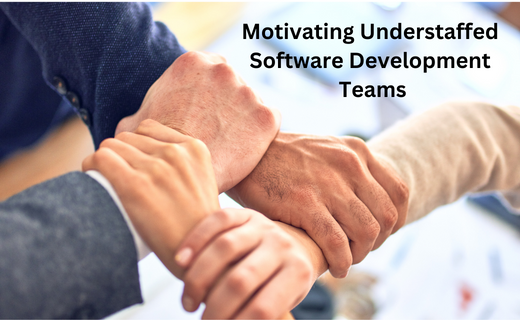-

Motivating Understaffed Software Development Teams
As companies continue to adapt to a shifting technological culture that involves an increased remote workforce, technology budget cuts, and staff shortages, stakeholders are searching for ways to keep their development ships afloat. To help you update your technology roadmap and account for these changes, an excellent place to start is to examine both the structure and engagement of your software development team.
Restructuring Your Software Development Team
Before making any significant changes to your team, you need to identify which roles are mission-critical. While certain specialized roles can either be outsourced or eliminated when staff cuts are inevitable, other roles are vital to the success of your projects. They should not be cut unless necessary:
Project Managers take overall responsibility for the progress and ultimate success of the project. Their duties range from intangible and morale-boosting to more technical aspects like project planning, monitoring, and control.
Quality Assurance (QA) Engineers ensure the software design and implementation adheres to quality standards set by both the development company and the client. Where the Project Manager ensures the work is completed on time, the QA Engineer ensures the product works as it should.
Lead Engineers or Team Leads act as mentors and guides to the rest of the development team. They have a bird’s eye understanding of their organization's core competencies and actively work to build full-stack solutions.
Getting More Done with Less
Engineers are great at getting the most out of limited resources. Being natural problem solvers, engineers thrive when they have to get creative with solutions. Working with an understaffed team presents an opportunity to develop a lean strategy and improve your team's efficiency. Here are some suggestions:
- Think big picture: it can be very easy for engineers to get lost in the weeds of their work and that can often lead to burnout. Help them remember who they’re building these solutions for and why. Sometimes taking a step back can help simplify the process and reduce wasted time and energy.
- Reuse, recycle, but don’t reinvent: While certain situations call for creating something new, engineers often may already have solutions (or partial solutions) at their disposal. Adapting old solutions to new problems can spark creativity and conserve precious financial resources.
- Leverage alternative resources: Coders have never had more available resources than they do now. Whether that’s open-source technology or engineering forums, developers can often find reliable help if they know where to look for it.
Dealing with Burnout
If you’ve had to reduce your technology budget or headcount, chances are your engineering team is operating under a higher stress level than usual. It’s no secret that software development carries one of the highest burnout rates of any industry, so keep your team motivated and engaged using the following strategies:
Train your troops: Developers are lifelong learners who generally like to know they’re doing meaningful work. They want their employer to be invested in their personal and professional development. Help them establish long-term goals beyond the scope of their current roles and skillsets.
Balance collaboration with solitude: As work from home becomes widespread, you must give your team plenty of opportunities to collaborate and interface with one another through the development process. Also, engineers need time to put their heads down and work alone. Find the balance!
Give praise and feedback: Most coding work is practically invisible once the final product is launched, so never underestimate the importance of recognizing your engineers for their hard work. Appreciation and feedback are the most underutilized tools managers have in their arsenal.
How to Measure Engagement
In addition to the above suggestions, you can leverage some more objective metrics to measure happiness and engagement in individual members of your software development team. No single one of these metrics tells the whole story, but they can work together to provide a more transparent link between how your engineers are feeling and how they’re performing:
- 1:1’s: Meeting team members one-on-one is sometimes the best way to gauge their feelings. Promote honesty and openness in these interactions. If engineers feel they can speak openly, they’re more likely to voice concerns or challenges they might be facing.
- Actual vs. historical hours: You can also examine the number of hours spent on a project vs. how long comparable projects have taken historically. Often, if current efforts require more time, it may be due to a lack of motivation or false expectations.
- Code churn trends: Engaged engineers will spend significant time rewriting and refining their code until it’s perfect. If the code churn rate declines, you may need to explore why.
- Project post-mortems: How do your engineers feel at the close of a project? Accomplished? Exhausted? Always follow up at the end of a project to see if anything might hinder their progress.
- Daily standup participation: You can observe the team during their standup meetings. How well are they meshing? Is anyone avoiding participation? Conversely, is someone dominating the conversation without enlisting feedback or collaboration from the rest of the team?
Identifying key development roles and doing all you can to build trust and engagement with your software engineers may not solve every problem that a reduced team and budget can introduce. Still, it can give you a solid foundation of trust and communication that you can continue to build on in the future.
Follow us on LinkedInAbout the Author

Kamal Rastogi is a serial IT entrepreneur with 25 yrs plus experience. Currently his focus area is Data Science business, ERP Consulting, IT Staffing and Experttal.com (Fastest growing US based platform to hire verified / Risk Compliant Expert IT resources from talent rich countries like India, Romania, Philippines etc...directly). His firms service clients like KPMG, Deloitte, EnY, Samsung, Wipro, NCR Corporation etc in India and USA.